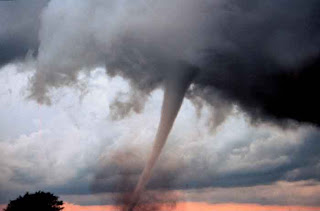What is tornado?
- As a column of swirling wind: an extremely destructive funnel-shaped rotating column of air that passes in a narrow path over land.
- An African windstorms: a short lived but severe windstorm, especially one that occurs I the West African Coast.
How tornados or how tornadoes form?
Tornados are form out of the bottom of Cumulonimbus cloud, where cold dry air meets the warm moist air where they are always associated with severe thunderstorms and accompanied by the clouds. Scientist studies how a tornado form and comes with the cold dry air with a downdraft or downward projection meeting against the warm moist air with an updraft or upward projection. Warm moist air rapidly rising upward through the cold dry air, until it reach in the near top of the cloud. As this happens, more warm moist air is coming in to replace it and cold dry air is forced to draft downward with a lesser quantity than warm moist air. This interaction of warm moist air and cold dry air will cause the warm moist air to rotate upward. And as more warm moist air coming up, it forms a vacuum like funnel-shaped cloud that sucks up anything it can usually dust, leaves of trees, water droplets etc. Tornadoes are made visible by the things it sucked in, from the dust and from the condense water droplets inside it. They commonly rotate counter-clockwise in the Northern Hemisphere and clockwise in the Southern Hemisphere.
How large and fast are tornadoes?
Size can vary from a few meters for about 100 meters, commonly 50 metres to about a kilometre wide. The biggest tornado size is 1 mile or about 2 kilometres wide. Tornadoes can travel in a distance ranging from a short hop to a kilometre, with the most destructive and fastest wind of 500 kilometres per hour. Commonly, the average speed of its wind is 75 kilometres per hour but the fastest is about 800 kilometres per hour.




No comments:
Post a Comment